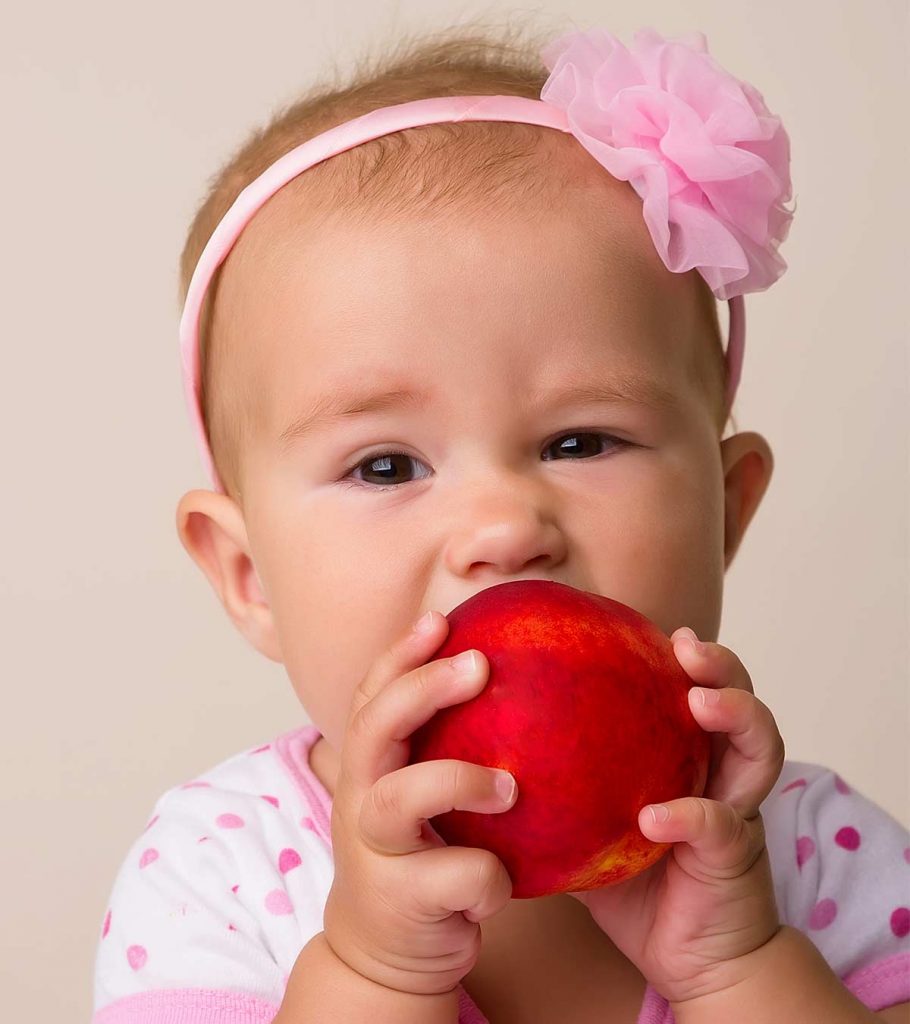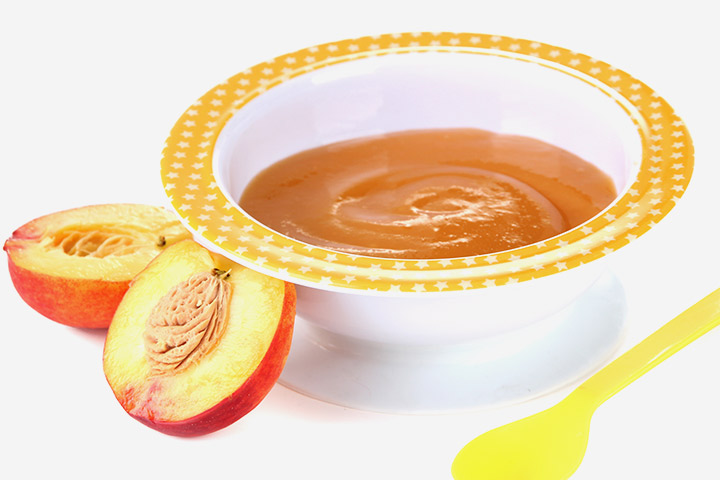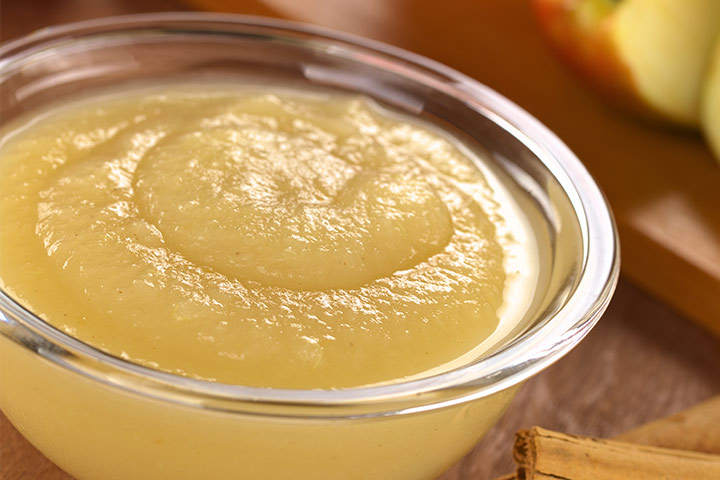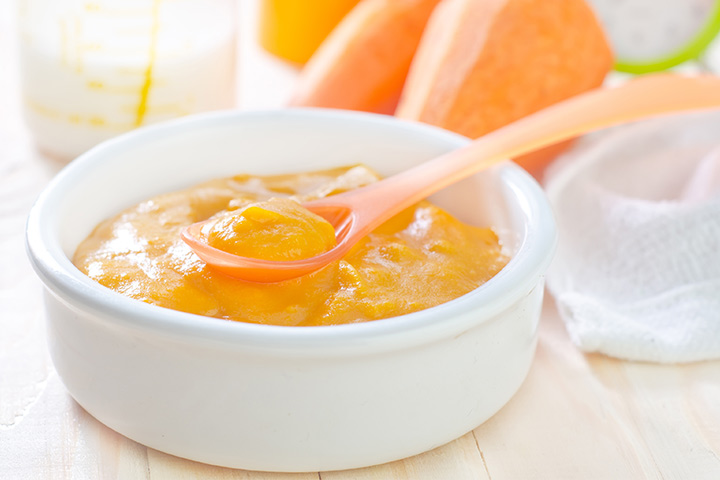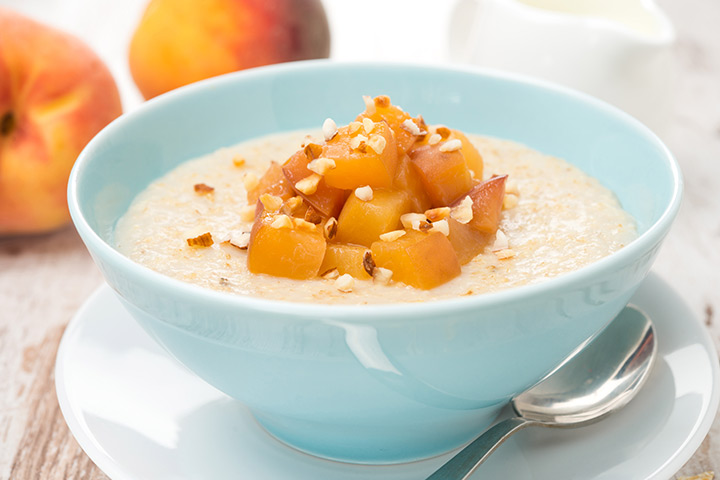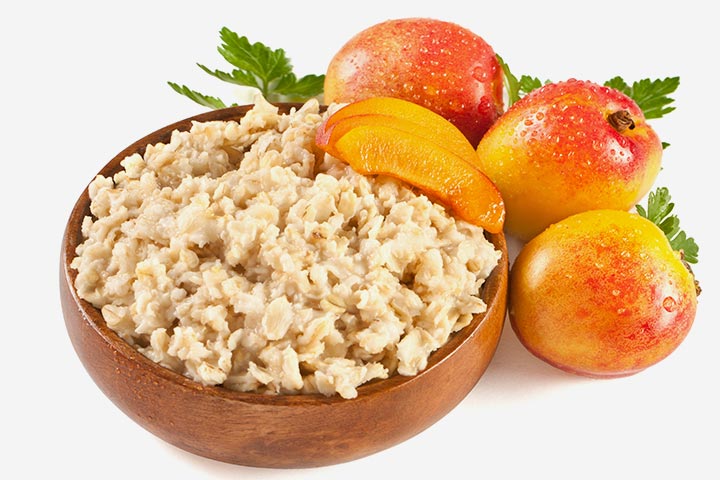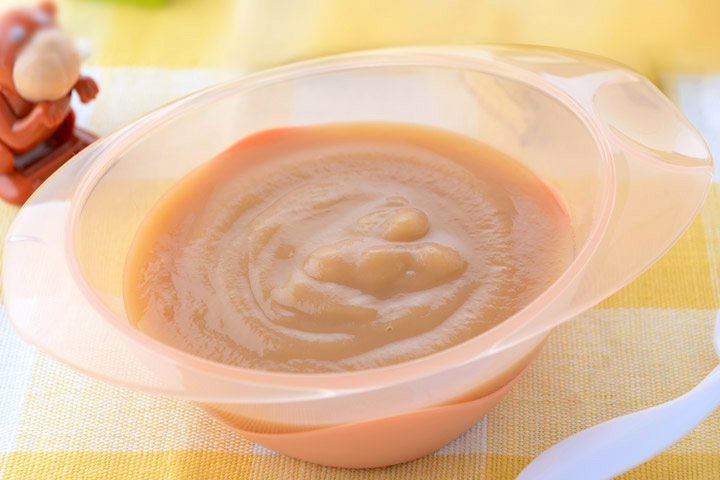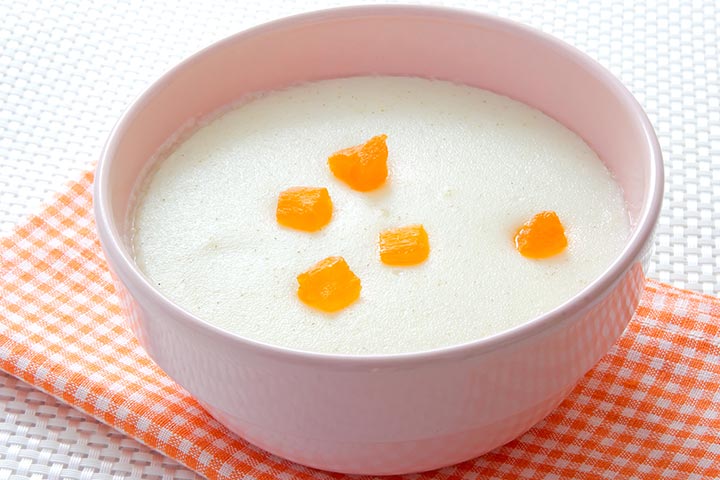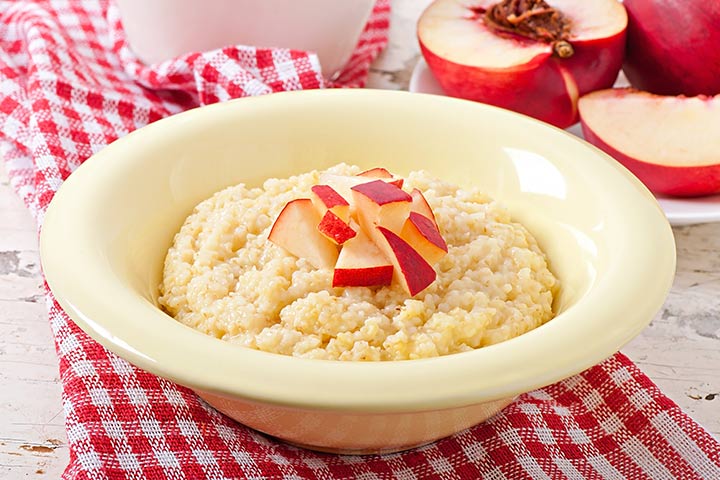It may be the best time for the introduction of peaches for babies when they start consuming solid foods. However, it is not recommended to give fresh peaches since their immature digestive system may struggle in the digestion of fresh fruits. Instead, you may make a ripe peach puree, and this luscious, sweet fruit puree can be palatable for your little one.
Peaches are also packed with beta carotene and potassium. You may also store and add peach puree with other vegetable or grain purees to make it more palatable.
Read on to know more about the benefits of peaches, how to choose and process them, and some interesting peach baby food recipes.
When Can Babies Eat Peaches?
Babies can have peaches from six months when you introduce solid food (1) as they are laden with nutrients.
Peaches and nectarines: Nectarine is a type of peach that has no fuzz on its skin but has the same taste, smell, and nutritional values as peaches (2) as peaches. It can be used interchangeably with peaches in food preparations.
Health Benefits Of Peaches
Peaches have rich antioxidant properties and several essential vitamins and natural sugars. Here are some amazing health benefits of peaches your baby can enjoy:
1. Beneficial for the eye
A medium-sized peach is rich in vitamins A and C, and antioxidants such as lutein, zeaxanthin, and beta-cryptoxanthin (3). These nutrients are important for the healthy development of the baby’s eyes and vision.
2. Keeps the baby hydrated
Peaches ripen during summers, and have 85% water, helping the baby stay hydrated.
3. Great for circulatory system
The abundant potassium present in a peach is good for the baby’s circulatory system (3).
4. Has no sodium
Excess consumption of sodium can be harmful to babies as their immature kidneys can’t process the mineral. They get enough from breastmilk. Peaches come with the goodness of nutrients and minerals, minus sodium.
5. Keeps bones and teeth healthy
According to the US Centres for Disease Control and Prevention (CDC), 23% of children aged two to five have dental caries in their primary (baby) teeth. Experts suggest that adequate fluoride intake may help prevent dental caries or tooth decay.
While fluoride is commonly found in water and toothpaste, it is also naturally present in foods like peaches. Peaches contain fluoride, essential for the healthy development of bones and teeth. They also have phosphorus and calcium, which are important for maintaining bone strength.
Nutritional Value
Here is the nutritional chart of the various nutrients found in 100gm of peaches.
| Nutrient | Unit Value Per 100 gm |
|---|---|
| Energy | 39kcal |
| Water | 88.87gm |
| Carbohydrates | 9.54gm |
| Natural sugars | 8.39gm |
| Fiber | 1.5gm |
| Protein | 0.91gm |
| Fat | 0.25gm |
| Calcium | 6mg |
| Iron | 0.25mg |
| Magnesium | 9mg |
| Phosphorus | 20mg |
| Potassium | 190mg |
| Zinc | 0.17mg |
| Copper | 0.068mg |
| Manganese | 0.061mg |
| Selenium | 0.1mg |
| Fluoride | 4mg |
| Vitamin C | 6.6mg |
| Vitamin B1 (Thiamin) | 0.024mg |
| Vitamin B2 (Riboflavin) | 0.031mg |
| Vitamin B3 (Niacin) | 0.806mg |
| Vitamin B3 (Pantothenic acid) | 0.153mg |
| Vitamin B6 | 0.025mg |
| Vitamin B9 (Folate) | 4µg |
| Choline | 6.1mg |
| Vitamin A | 16µg |
| Vitamin E | 0.73mg |
| Vitamin K | 2.6µg |
Source: United States Department of Agriculture (4)
How To Select And Store Peaches?
Selection: The best time to buy fresh peaches is from May to October. When selecting the fruit, look for a hue of pink and orange. Ripe peaches have soft skin and will be slightly yielding to the touch. The skin will also be smooth and fuzzy. Prefer those that have no bruises or blemishes and have clear skin. Peaches are among those fruits and vegetables that are most likely to be contaminated with pesticides (5). Therefore, go for the organic variety if you can.
Storage: Remember to wash the peaches thoroughly under running water, which will remove the residues of pesticide present on the skin. Peaches ripen after being plucked so you can select slightly unripe varieties to store longer.
Refrigerate the fruit in a regular basket or in a food-grade plastic bag. If the peaches are slightly unripe, then place the food-grade plastic bag at room temperature for a few days, for the fruits to ripen. The fruit tastes the best at room temperature so place it outside the refrigerator for a few minutes before processing it.
How To Process Peaches For Babies?
Processing the peaches for baby food is easy and simple. You can boil, steam, bake, or directly puree them with the last option suitable for older infants. Do not peel the peaches as the skin is rich in nutrients. You may gently scrape or peel the sections of the skin with blemishes or stains, and retain the rest. Here are the various ways of processing peaches:
- Boil: Bring three to four cups of water to full boil and add chopped peaches to it. Boil the fruit for three to five minutes. Once the peach is tender, take it off from the water and cool for two minutes before processing them.
- Steam: Cut the peach into large pieces and place them in a pan with shallow water that does not submerge the fruit. Close the lid of the pan and bring the water to boil, and then simmer for four to five minutes. You can steam them for longer to make them more tender.
- Bake: Preheat the oven to 200ºC. Cut the peach into four large pieces and place them in a baking tray with no more than two inches of water in it. Bake them for about 40 minutes or till the skin starts puckering.
Cooking peaches softens the skin, which makes it easier for young infants to consume. For older babies who are on a regular diet of solid finger food, the peach can be pureed directly with the skin since it would not be a choking hazard. Do ensure that the fresh peach is pureed finely with no large chunks of fruit.
Frozen peaches can be used for puree provided they are fresh and were stored in hygienic conditions. Canned peaches are good for immediate consumption, but they could contain bisphenol A (BPA) (6) and babies can be primarily susceptible to the ill-effects of BPA . Also, canned food may contain added sugar or sodium to increase shelf life, which is bad for the baby’s health. You can use canned peaches for babies, provided the can is BPA-free and devoid of preservatives.
Peach puree can be frozen for later use. However, do not refreeze a thawed peach puree as the temperature fluctuation can make it sour and prone to bacterial contamination. Also, use the frozen puree within three days to prevent loss of flavor and texture. Always give preference to fresh fruit over frozen and canned variants.
Amazing Peach Recipes For Babies
Peaches can be among the first foods for babies, ideal for their meals or as a snack. Now that we know how to process them, let us look at these peach baby food recipes you can serve your little one.
1. Peach puree
The classic peach baby food recipe is easy to make packing all the goodness of peaches.
You will need:
- 1 cup chopped peaches
- 2-3 cups of water
How to:
- Process the peaches by either boiling, steaming, or baking them. Once done let the peaches cool a bit. Do not throw the stock/leftover water since you can use it later.
- Place the peaches in the blender, add the peach stock and some more water to it. Blend until the desired consistency is achieved. You could use more water to thin the puree.
2. Peach and apple puree
Combining apple’s tartness with the sweetness of peaches gives you this amazing baby food puree.
You will need:
- 1 cup chopped peaches
- 1 cup chopped apples
- 3-4 cups of water
How to:
- You can cook peaches and apples together to save time. Cook till the food is tender and retain the fruit stock.
- Pour the fruit, fruit stock, and additional water in a blender and blend to the desired consistency.
- If the tart taste from apples seems to dominate, then add more cooked peaches and blend again. This will sweeten the puree naturally.
3. Peach mango puree
This is a sweet delight thanks to a great combination of two naturally sweet fruits.
You will need:
- 1 cup chopped mangoes
- 1 cup chopped peaches
- 3-4 cups of water
How to:
- Cook the peaches by boiling, steaming, or baking them. Fresh mango pulp is tender and will get cooked faster than peaches. For this reason, cook it separately.
- Pour the cooked fruits and fruit stock into a blender and blend them till the desired consistency. Add some additional water if necessary.
4. Peach and carrot puree
Peaches are rich in vitamin A while carrots in beta carotene – a compound that is essential for natural vitamin A synthesis in the body. Vitamin Ais essential for a good vision and for healthy bone growth.
You will need:
- 1 cup chopped peaches
- 1 cup chopped carrot
- 3-4 cups water
How to:
- Cook the peaches by boiling, steaming, or baking. Cook the carrots separately since they will take more time to cook.
- Mix the cooked carrots with peaches and blend them together to the desired consistency.
- Carrot stock is exceptionally rich in nutrients, therefore, do not throw it away. Use the stock to blend the ingredients
5. Peach and rice flour porridge
Rice provides the carbohydrate while peaches are vitamin-rich and provide the minerals making this preparation a complete peach baby food.
You will need:
- 1 cup chopped peaches
- 2 cups rice flour
- 3-4 cups water
How to:
- For this recipe, you can boil the peaches first and then use the fruit stock to cook the rice flour. Mix the rice flour with the fruit stock and cook while stirring.
- Add some additional water if needed and cook till there are no lumps and the rice flour is cooked.
- Blend the peaches separately to make a peach puree and then mix it with the rice flour. Cook for a couple of minutes before completion.
6. Oatmeal and peach porridge
Oats are rich in fiber, and when combined with sweet peaches they make a great preparation.
You will need:
- 2 cup broken/coarsely grounded oatmeal
- 1 cup chopped peaches
- 4 cups of water
How to:
- Quite similar to the rice porridge, cook the peaches first and then use the remainder of the water to cook the oatmeal.
- Cook the oatmeal till they are completely tender. Do not drain away the excess water.
- Mix the peach puree, that you make separately, with the oatmeal and cook for a minute to complete the preparation of this amazing porridge.
7. Barley and peach porridge
Peaches are rich in multivitamins and so is barley. The grain is also rich in fiber, making this porridge highly nutritious.
You will need:
- 2 cups coarsely grounded barley
- 1 cup chopped peaches
- 4 cups water
How to:
- Make the peach porridge as explained above. Use the fruit stock to cook the grain.
- Barley takes longer to cook than rice or oats. Therefore, add some extra water in the cooking pot along with the fruit stock.
- Once cooked, mix the barley with the pureed peaches to cook for one or two minutes before cooling and feeding it to your baby.
8. Ragi (finger millet) and peaches puree
Ragi or finger millet is a grain that is rich in several essential amino acids, which are the building blocks for proteins. When combined with peaches, this preparation makes an extremely healthy peach-based baby food.
You will need:
- 2 cups ragi/finger millet flour
- 1 cup chopped peaches
- 3-4 cups water
How to:
- Process the peaches first to blend them into a puree. Mix the ragi flour with the fruit stock with some additional water to it.
- Keep stirring the ragi to prevent the formation of any lumps and to ensure that the ragi cooks consistently.
- Add the puree to the ragi flour mix, cook for a couple of minutes and the healthy porridge for your baby is ready.
9. Sabudana (sago pearls) and peaches porridge
Sabudana or sago pearls are gentle on the infant’s stomach while also being rich in carbohydrates. They taste incredibly great when combined with the sweet pulp of peaches.
You will need:
- 2 cups broken sabudana/sago pearls
- 1 cup chopped peaches
- 3-4 cups of water
How to:
- Begin by cooking the sago pearls since they are firmer and require a long time to cook.
- Cook the peaches and blend them into a puree. You can use the extra water to cook sago pearls.
- Once the sago pearls are cooked and tender, mix the peach puree to it, and cook the mixture for two to three minutes to complete the process.
10. Wheat and peaches porridge
Wheat can be great for your baby if he is not allergic to it. Wheat and peach porridge will be healthy and delicious for a growing infant.
You will need:
- 2 cups broken wheat
- 1 cup chopped peaches
- 3-4 cups of water
How to:
- Cook the broken wheat in water till they are completely tender without any hard chunks.
- Puree the peaches after cooking them and keep them on standby till the wheat is cooked.
- When the wheat is cooked, pour the puree into the wheat and water mix to cook for two to three minutes and then cool it before serving it to your baby.
Those were some amazing homemade baby food peach recipes that are high in nutrition and taste great. There are other great peach baby food ideas you can easily make by combining them with other food items.
Peach Baby Food Combinations
Here are some foods that can taste great when combined with peaches:
- Baby cereals: Baby cereals tend to be bland, and a young baby may get bored of having it every day. To make it more interesting, mix it with peach puree to add a level of sweetness that can make baby cereals more palatable.
- Vegetables: Peaches render their unique flavor to standard vegetable purees making it all the more interesting for your baby. Mix with any vegetable such as carrots, peas, beans, pumpkin, etc.
- Yogurt: Fruit-flavored yogurts are not just for adults. Make a version for your baby by mixing homemade yogurt and peach puree to create a lip-smacking infant food.
- Fruits: You can blend peaches with other fruits to make a host of fruit purees that your baby will love for their natural sweetness.
Can My Baby Be Allergic To Peach?
Peaches belong to the plant family called Rosaceae that consist of plants with an inclination to trigger allergic reactions through their fruits (7). Raw peaches are among the most allergenic foods, but their allergenic properties significantly decrease when they are cooked (8). If your baby is allergic to any other fruit or nut from the Rosaceae family such as apricot, apple, cherry, plum, hazelnut, almonds, and walnuts, then he is quite likely to be allergic to peaches (9).
Peach allergy can be common, which makes it important to be vigilant about any symptoms of allergy when introducing any form of peaches to your baby. Following are the common symptoms that you may notice in a bout of food allergy:
- Shortness of breath: General breathlessness with wheezing and long gasps of breathing
- Skin hives: Small red bumps on the skin that are noticed in clusters
- Swelling of mouth: Lips and tongue would inflame along with swelling in neck muscles
- Abdominal pain: Pain in abdominal cavity could be accompanied by vomiting and diarrhea
- General weakness: The baby will feel weak and dizzy with constant fatigue
You may incorporate delicious and nutritious juicy stone fruits such as peaches for babies as a part of their weaning diet. Apart from several health benefits, peaches are high in water content and packed with essential nutrients, including iron, calcium, fiber, and natural sugars. You may begin with small quantities of peach puree to feed your little one. If it suits them, you may combine peaches with other fruits and customize recipes as per your baby’s taste preferences. However, if you detect any signs of allergy in your babies, seek immediate medical attention.
Key Pointers
- Peaches can be added to a baby’s diet after six months.
- It can promote healthy vision development, strong bones and teeth, and a good circulatory system.
- Be cautious of any allergic reactions when feeding peaches to a baby for the first time.
- Peaches can be prepared for babies by boiling, steaming, baking, or pureeing.
- You may try adding peaches to baby cereals, yogurt, and dishes for older babies.
